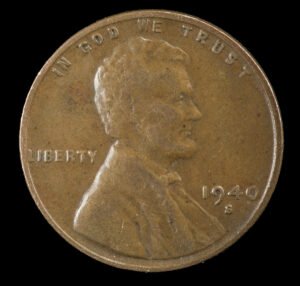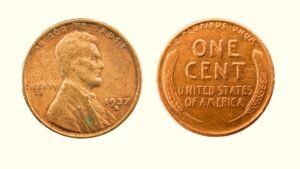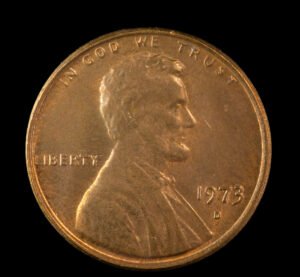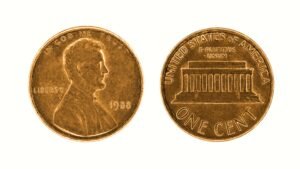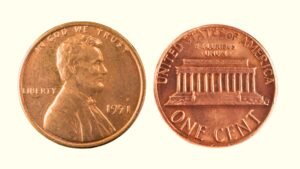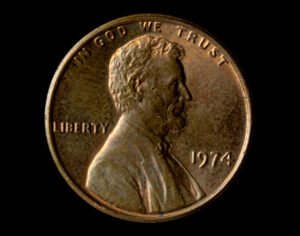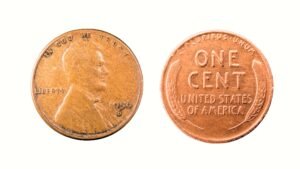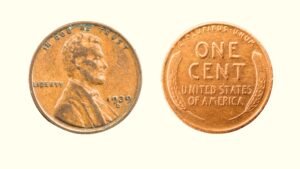The 1961 Lincoln penny may seem like just another old coin, but this small copper cent can fetch astonishing prices—up to $6,600! So, if you have an old 1961 Lincoln Penny in your change jar, this article is just for you! From its iconic design to rare errors, this value guide explores all rare features and factors influencing a 1961 Lincoln Cent value!
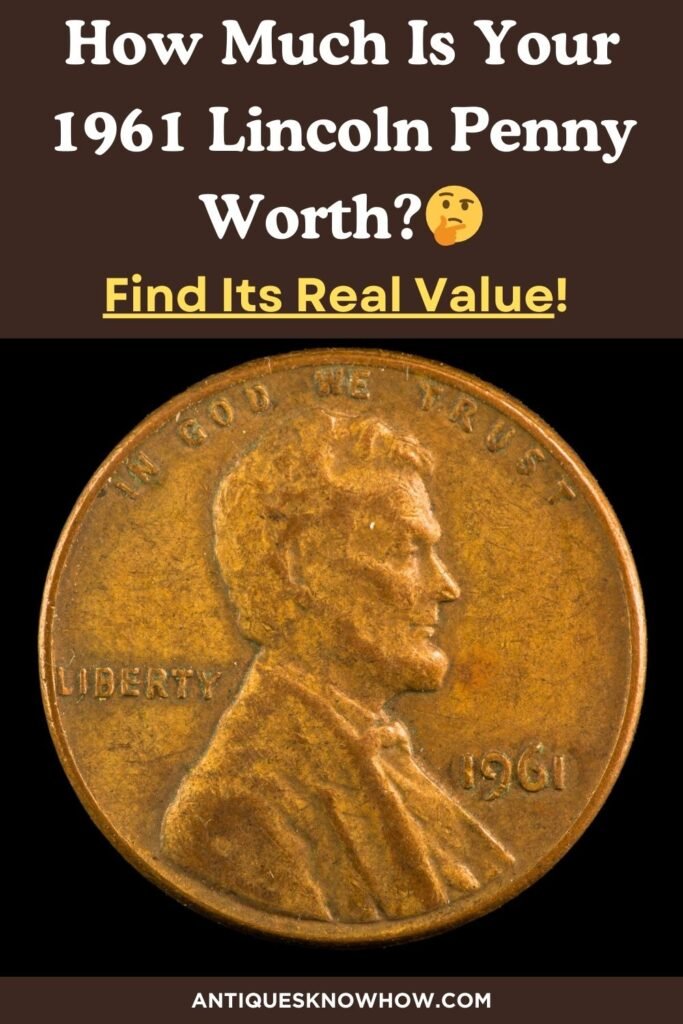
A standard 1961 Lincoln penny in average condition with a worn-out design is valued at around $0.03 to $0.05, whereas coins in excellent condition and with rare features can reach high values of up to $5,000 or more!
Brief History of the 1961 Lincoln Memorial Cent
The Lincoln penny was started in 1909 to honor President Lincoln. Over the years, its design changed a few times. By 1961, the penny had the Lincoln Memorial building on the back, the design that had been there since early 1959.
There were a few other changes as well. For example, the 1960 penny had different mint date size varieties (small date and large date), but in 1962, all pennies had the same date size. The composition, however, remained the same: bronze alloy with 95% copper content.
The substantial mintage of over 2.5 billion coins proves that the 1961 Lincoln Penny was greatly in demand. Nonetheless, no coins were struck at the San Francisco Mint this year. The Philadelphia and Denver Mint produced millions of coins, several of which had rare errors and are highly collectible today.
| 1961 Lincoln Memorial Cent | Key Features & Facts |
| Coin Composition | 95% Copper, 5% Tin and Zinc |
| Minting Location | Philadelphia, Denver |
| Minting Year | 1961 |
| Face Value | 1-cent (0.01$) |
| Weight | 3.11 grams |
| Diameter | 19.05 mm |
| Thickness | 1.52 mm |
| Designer | Victor David Brenner, Frank Gasparro |
| Mint Marks | D – Denver Mint, No Mint Mark – Philadelphia Mint |
| Total Mintage | 2,509,639,944 coins |
How to Identify a 1961 Lincoln Penny Design & Composition
To find the real value of a 1961 Lincoln penny, you must identify its distinctive features and composition, which are as follows:
1961 Lincoln Penny Obverse:
The obverse of the 1961 Lincoln Cent features the traditional design featuring Abraham Lincoln, along with other inscriptions:
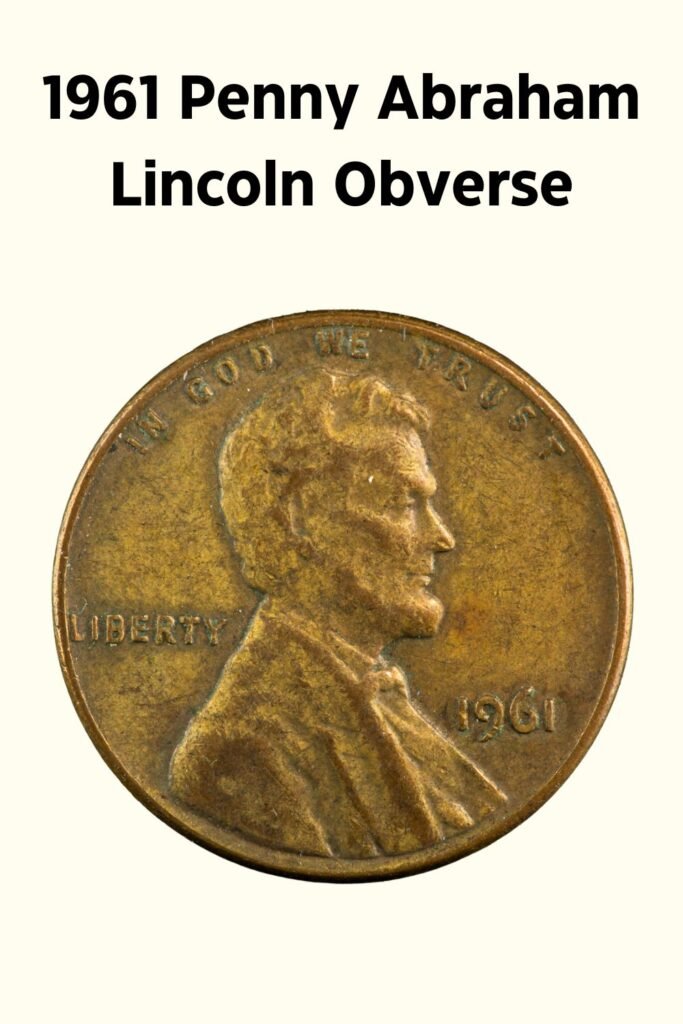
- A right-facing portrait of Abraham Lincoln
- The motto “IN GOD WE TRUST” above Lincoln’s head along the edge
- The word “LIBERTY” to the left of Lincoln’s bust
- The mint date “1961” to the right of Lincoln’s bust
- The mint mark, D, if present, below the mint year
- The designer’s initials (VDB from Victor David Brenner) below Lincoln’s shoulder (hard to see)
1961 Lincoln Penny Reverse:
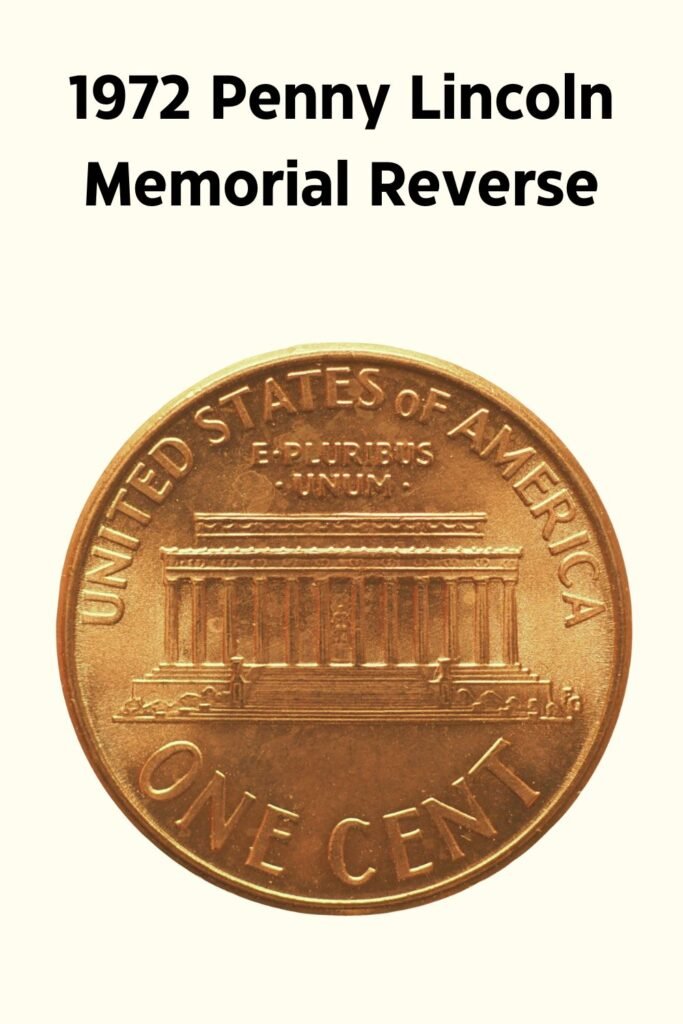
- The depiction of the Lincoln Memorial at the center
- The words “UNITED STATES OF AMERICA” along the top edge
- “E PLURIBUS UNUM” above the Lincoln Memorial
- The denomination “ONE CENT” at the bottom
- The designer, Frank Gasparro’s initials “FG” on the right of the staircase
Note: Pay attention to the number of stairs in the Lincoln building. Generally, there are six steps, and coins with all five or six stairs visible are valuable!
1961 Lincoln Penny Coin Composition & Dimensions
Till 1961, the United States Mint continued using bronze composition with 95% copper and 5% zinc for the Lincoln pennies. This composition gave the cent its distinctive weight of approximately 3.11 grams (0.110 ounces) and a unique red luster.
The cent coin measures around 19.05 millimeters (0.75 inches) in diameter and 1.52 millimeters (0.059 inches) in thickness, and it has a distinctive smooth edge.
3 Factors That Determine a 1961 Lincoln Penny Value
Several factors, including coin condition, rarity, specific mint marks, and minting errors, play a significant role in assessing a 1961 Penny’s worth.
1. Coin Grading and Toning
The value of a 1961 Lincoln penny can majorly depend on its condition, which is analyzed on a grading scale. The scale ranges from PO-1 (Poor Quality) to MS-70 (Mint State Gem).
Generally, 1961 pennies in mint state are worth decent money, while lower-grade coins are worth only a few cents.
The toning of a Lincoln penny, another aspect of its condition, also directly impacts its value. To assess a 1961 penny value based on coin colors, the following three color designations are crucial:
- Red (RD): Red coins have more than 95% of their original red luster and are the most valuable. Uncirculated RD 1961 pennies can be worth $10 to a few thousand dollars.
- Red-Brown (RB): Red-brown pennies display both red and brown patches due to partial oxidation. They can still fetch around $5 to $10 in high-mint state grades.
- Brown (BN): As the name suggests, Brown pennies have turned completely brown due to extreme oxidation. These coins are the least valuable, fetching only a few cents.
2. 1961 Lincoln Mint Marks Value Guide
| Coin Grades | Condition Details | 1961 No Mint Mark Penny Value | 1961 D Wheat Penny Value |
| Poor (0) to Extremely Fine (XF45) | Significant wear, faded but visible details | 1-5 cents | 1-5 cents |
| Almost Uncirculated (AU50) to Mint State (AU58+) | Slight wear on highest points, visible marks or blemishes | 20 cents to 50 cents | 10 cents to 30 cents |
| Mint State (MS60 – MS64) | Uncirculated with minimal wear | $2 – $10 | $1 – $8 |
| Mint State (MS65 – MS66+) | Nearly flawless with very minor imperfections | $7 – $150 | $7 – $200 |
| Mint State (MS67 – MS67+) | Well-preserved with no major flaws | $160 – $1,500+ | $100 – $1,000+ |
| Mint State (MS68 or Above) | Nearly perfect, luster, no major marks or flaws | N/A | N/A |
The rarity of a coin, which directly influences its value, largely depends on its total mintage. Higher mintage means the coin is easily available and, hence, less valuable. The mintage of the 1961 penny changes from location to location.
1961 No Mint Mark Penny Value (Mintage – 753,345,000)
If your 1961 Lincoln Memorial penny has no mint mark, it was produced at the Philadelphia Mint. With a total mintage of over 753 million, these coins are quite common and fetch only 1-5 cents in circulated condition.
Uncirculated 1961 penny no mint mark coins can be worth around $5 to $20, with MS67 grades or higher reaching up to $700 or more. For example, an MS67RD 1961 No Mint Mark penny sold for $720 on Heritage Auctions in 2023.
The highest auction record price for a 1961 Lincoln Penny in MS67 grade is $5,720, sold at the Great Collections‘ coin auction!
1961 D Lincoln Penny Value (Mintage – 1,753,266,700)
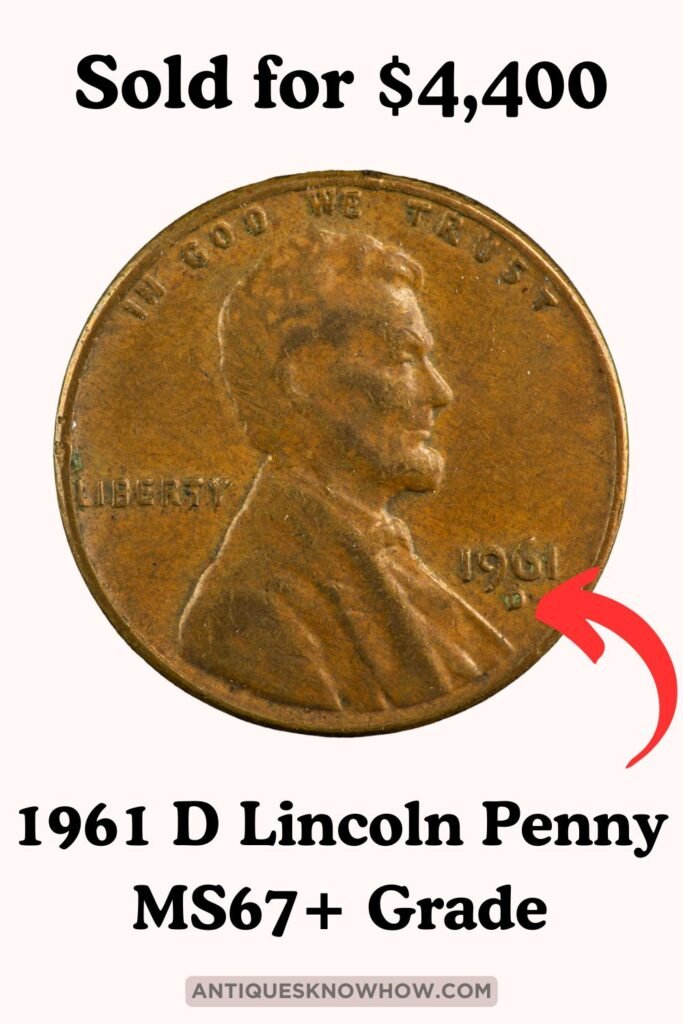
The Denver Mint produced over 1.7 billion 1961 Lincoln cents, which means they are more common and less valuable than the no-mint mark pennies. 1961 D Lincoln pennies are also worth about 1-3 cents in circulated condition but can fetch up to $600 in MS67 condition.
However, some dedicated coin collectors can pay exceptionally high prices for this coin. For example, one collector bought an MS67 1961 D Penny for over $4,400!
1961 No Mint Mark Proof Penny (Mintage – 3,028,244)
The Philadelphia Mint also produced over 3 million special proof varieties of the 1961 Lincoln Memorial cent for coin collectors. While these pennies bear no identifiable mint mark, you can spot them by their shiny, reflective surfaces, unique toning, and sharp details.
The Lincoln proof coins are further categorized as follows based on different proof finishes:
- Regular PR Proofs: These proof coins feature a mirror-like proof finish. Generally, red 1961 proof pennies are worth their face value in PR-60 to PR-63 grade, while higher-grade examples like PR-67 to PR-69 can be worth $20 to $100 or more.
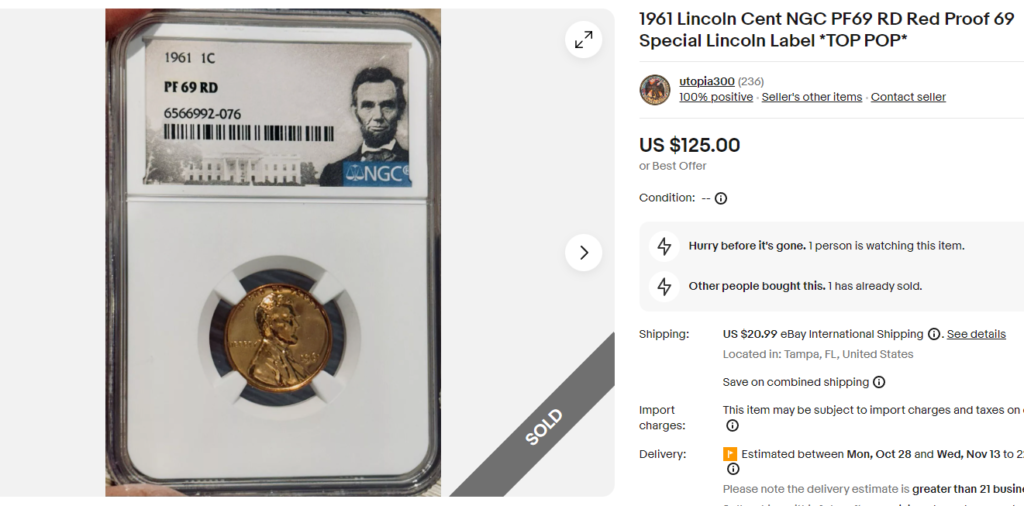
- Cameo (CAM) Proofs: 1961 penny proof coins that feature a contrast between frosted designs and mirrored backgrounds are called Cameo proofs. PR-60 to PR-64 grade Cameo 1961 penny coins are worth a few cents to $1, while higher grades like PR-65 to PR-68 can fetch $15 to $60. You can get PR-69 Cameo coins for $80 to $1,000!
- Deep Cameo Proofs: These coins feature the strongest contrast on the surfaces. Deep Cameo 1961 Lincoln penny proof coins can command prices exceeding $5,000 in PR-69 grade. PR-68 examples can also easily sell for $200 to $600, while lower-grade examples are worth $20 to $100.
3. Rare 1961 Penny Errors
Like many old coins, the 1961 Lincoln pennies might have interesting production errors that can double or triple their average value. However, not all errors fetch high prices. Here are some of the most valuable 1961 penny errors to look for:
Double Die Errors
Double die errors in the 1961 Lincoln penny can occur on the obverse (DDO) and reverse (DDR). These errors happen when the die is misaligned during the engraving process, resulting in a noticeable doubling effect, which is then impressed on the penny during minting.
For DDO, inspect the doubling on:
- The lettering in “Liberty”
- The mint date “1961” for extra thickness or shadows
- The letters in the “In God We Trust”
For DDR, look for doubling effect in:
- The letters in “ONE CENT.”
- The lettering in the “UNITED STATES OF AMERICA”
The values of high-grade 1961 Lincoln Memorial cents with well-defined double dies can range from $100 to several hundred dollars. Remember that the value also depends on the quality and clarity of the doubling.
Struck on a Silver Dime Planchet
This error occurred when a penny was struck on a silver planchet intended for a dime. To identify and check the weight and features. The coin will be smaller, silvery in color, and weigh about 2.5 grams instead of 3.11 grams.
Depending on the condition, the values of this rare error coin can range from $500 to $2,500. For example, an MS62-grade 1961 Penny struck on a dime planchet sold for almost $1,000 on Heritage Auctions! If found, MS65 or higher-grade examples of this error coin can be more valuable.
1961 D Penny Re-punched Mint Mark (RPM)
The 1961 1C re-punched mint mark (RPM) error occurs when the mint mark is stamped multiple times, causing it to appear doubled or misaligned. Check the “D” for signs of doubling. The most significant identification signs are visible overlaps.
1961-D Penny with RPMs can be valued from $20 to $200, depending on the clarity of the error and the overall condition of the coin.
Off-Center Strikes
A 1961 Penny off-center strike happens when the coin is not properly aligned during the striking process, resulting in part of the design being cut off. To identify this error, look for a significant portion of the Lincoln design or lettering missing.
The degree of the off-center will impact value. The more off-center and the more visible the date, the higher the value. For example, an MS64 1961-D 1C Lincoln Cent Struck 90% Off Center sold for $94, while one with an 80% off-center strike sold for $79 at Heritage Auctions!
In addition to these errors, be on the lookout for common die break errors and clipped planchet errors. They can also make your old 1961 penny much more valuable than its face value!
Note: This article is intended for informational, educational, and entertainment purposes only. Some images are illustrative and may not represent actual brands, products, or related entities. All trademarks, product names, brand logos, packaging, and other intellectual property referenced remain the exclusive property of their respective owners. Any brand mentions or references are provided solely for descriptive and educational context and do not imply any formal or commercial association.


